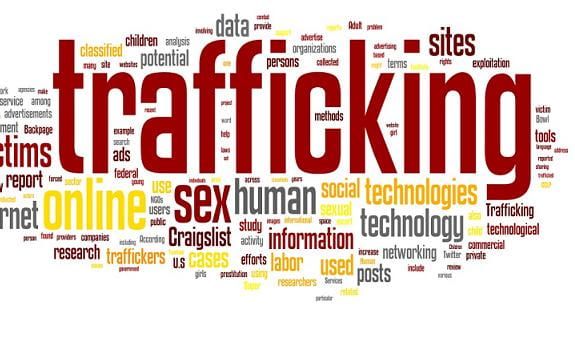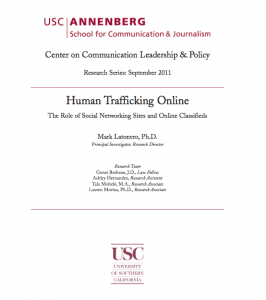A Project of the USC Annenberg Center on Communication Leadership & Policy
University of Southern California
Executive Summary
This report presents a comprehensive examination of the role of social networking sites and online classified ads in facilitating human trafficking and delivers recommendations for developing technological innovations to monitor and combat trafficking.
Human trafficking, a form of modern-day slavery, is a grim reality of the 21st century global landscape in developed as well as developing countries. While traditional channels of trafficking remain in place, online technologies give traffickers the unprecedented ability to exploit a greater number of victims and advertise their services across geographic boundaries.
Yet the extent to which online technologies are used in both sex and labor trafficking is unclear, and the current approach to the question is lacking. While online classified sites such as Craigslist have already been under intense scrutiny for being used by traffickers,1 little research is available on the role of online classified and social networking sites in human trafficking, and the issue has yet to be fully studied. Instead of singling out these technologies as a root cause of trafficking, this report poses the following question: Can online technologies be leveraged to provide actionable, data-driven information in real time to those positioned to help victims?
 This study forwards the hypothesis that tools such as data mining, mapping, and advanced analytics can be used by governmental and nongovernmental organizations, law enforcement, academia, and the private sector to further the anti-trafficking goals of prevention, protection, and prosecution. Adapting these technologies and methods requires careful consideration of potential implications for civil liberties, such as privacy and freedom of expression. This report applies detailed methods to understanding the relationship between domestic human trafficking and online technologies through literature reviews, field research, and interviews. In addition, the report presents preliminary results from primary research in developing tools to assist law enforcement and anti-trafficking efforts. The report concludes with a set of recommendations and guidelines to inform future research and technological interventions in human trafficking.
This study forwards the hypothesis that tools such as data mining, mapping, and advanced analytics can be used by governmental and nongovernmental organizations, law enforcement, academia, and the private sector to further the anti-trafficking goals of prevention, protection, and prosecution. Adapting these technologies and methods requires careful consideration of potential implications for civil liberties, such as privacy and freedom of expression. This report applies detailed methods to understanding the relationship between domestic human trafficking and online technologies through literature reviews, field research, and interviews. In addition, the report presents preliminary results from primary research in developing tools to assist law enforcement and anti-trafficking efforts. The report concludes with a set of recommendations and guidelines to inform future research and technological interventions in human trafficking.
The use of Internet technologies in people’s daily lives has dramatically increased in recent years. In 2010, the number of Internet users worldwide exceeded an estimated 2 billion people.2 Hundreds of millions of individuals use social networking sites,3 and approximately half of all online adults in America have used online classified advertising sites.4 In contrast to the many social benefits that Internet technologies provide, a darker narrative also has emerged. Social networks and online classified sites are being used by traffickers to market, recruit, sell, and exploit for criminal purposes. Many of these sites are explicit in nature and some are underground. Yet, evidence from legal cases demonstrates that mainstream sites such as Craigslist, Backpage, and Myspace have already been used for trafficking.5 Facebook, Twitter, and other social networking sites are susceptible to similar uses.
Because human trafficking is a crime recognized by international protocols and state laws, traffickers are traditionally forced to conduct their activities underground. But this report illustrates that online transactions leave behind traces of user activity, providing a rare window into criminal behavior, techniques, and patterns. Every online communication between traffickers, “johns,” and their victims reveals potentially actionable information for anti-trafficking investigators.
Until now, there has been a lack of data on the role of online technologies in human trafficking. Yury Fedotov, executive director of the United Nations Office on Drugs and Crime, remarked: “We do not have an accurate picture of the scope and nature of [the misuse of technology] and cannot act as effectively as we should. Knowledge is essential for evidence-based policy, and we must fill the information gap.”6
The Annenberg Center on Communication Leadership & Policy (CCLP) at the University of Southern California launched an anti-trafficking initiative in response to a similar call for increased knowledge. The project began at a June 2010 meeting CCLP Director Geoffrey Cowan convened in Washington, D.C., at the urging of Alec Ross, Secretary of State Hillary Clinton’s senior adviser for innovation, and Ambassador Luis CdeBaca, head of the State Department’s Office to Monitor and Combat Trafficking in Persons. Representatives from the U.S. Agency for International Development, the Department of Justice, the Senate Foreign Relations Committee, and the United Nations joined leaders from the technology field, nongovernmental organizations, and academia to discuss the use of technology to address trafficking.
The meeting set into motion research initiatives in the Mekong Subregion (including Thailand, Cambodia, and Vietnam), Haiti, and the United States. An absence of technological solutions for information sharing among anti-trafficking organizations inspired further study into potential uses of technology in this field. A partnership between the USC Information Sciences Institute and CCLP developed prototype software designed to detect possible cases of online sex trafficking activity, particularly cases involving underage victims. Together, the group conducted advanced research on data mining, computational linguistics, and mapping tools to monitor trafficking on social networking and online classified sites. Feedback from the Federal Bureau of Investigation was integral to this process.
This report indicates that immediate action is required to develop monitoring and prevention techniques to combat human trafficking online. The report recommends future research and proposes actions that stakeholders can undertake to address trafficking online. Comprehensive solutions to trafficking through online channels should involve proactive steps by governments to protect victims and support law enforcement in combating a new generation of tech-savvy traffickers. At the same time, this report urges private-sector technology firms to recognize the opportunity to address human trafficking on their networks and services. In addition, NGOs and academics bring needed expertise to technological interventions. This study also identifies technological innovations that can be used by actors and stakeholders involved in anti-trafficking efforts. To that end, the following principles are intended for those seeking to employ technology as a means to combat human trafficking:
Guiding Principles for Technological Interventions in Human Trafficking
- The ultimate beneficiaries of any technological intervention should be the victims and survivors of human trafficking.
Throughout the technological design and implementation process, decisions should be guided by a single question: How will technology maximize the benefit and minimize the harm to victims and survivors of trafficking?
Developers and users of anti-trafficking tools should examine the inherent risks that arise when technology is applied to complex social problems. While benefits may appear clear at first, experts should be consulted to evaluate whether tools have the potential to cause inadvertent harm.
- Successful implementation of anti-trafficking technologies requires cooperation among actors across government, nongovernmental, and private sectors, sharing information and communicating in a coordinated manner.
Technological interventions in anti-trafficking efforts necessitate collaboration across sectors. Addressing trafficking online requires coordination of efforts to avoid inefficiencies, for example, when a proposed technology is already in use by parallel organizations or when existing technologies can readily be adapted to fit anti-trafficking needs. The private sector, academics, and the technology community can serve as valuable resources for creative innovations that can be tailored to anti-trafficking, including technologies to facilitate information sharing.
- Private-sector technology firms should recognize that their services and networks are being exploited by traffickers and take steps to innovate and develop anti-trafficking initiatives through their technologies and policies.
Social networking sites, online classified sites, and technology firms provide Internet services that criminals are using to facilitate domestic and international trafficking in persons. These companies should consider their social responsibility and assume an active role in combating trafficking on their sites. Whether through practices such as establishing industry-wide codes of conduct or innovating technological solutions, the private sector can exercise considerable influence in anti-trafficking efforts.
- Continuous involvement is necessary to ensure that tools are user-centric and refined over time to most effectively respond to shifts in technology and trafficking.
User-centered design principles should aim to improve functionality and usability by focusing on the particular needs of users of anti-trafficking technologies. Law enforcement, NGOs, service providers, and the public each have particular needs based on technological literacy, class, and language, among other factors.
Furthermore, technological interventions must be supported by individuals committed to sustaining the technology over time. Both governmental and nongovernmental actors can play a key role in providing expertise and support for anti-trafficking innovations.
- Technological interventions should account for the range of human rights potentially impacted by the use of advanced technologies.
Technologies used in anti-trafficking efforts should be carefully tailored to avoid recklessly encroaching upon fundamental rights such as privacy, security, and freedom of expression. Developers and users of the technology must reflect on the full range of rights implicated by any information-collecting activity, taking particular care to reduce the number of false positives associated with tracking and monitoring.
Notes
- Domestic Minor Sex Trafficking: Hearings on H.R. 5575, Before the Subcommittee on Crime, Terrorism, and Homeland Security, 111th Cong. (2010).^
- International Telecommunication Union (ITU), The World in 2010, ICT Facts and Figures, 2010.^
- “Morgan Stanley estimates that there were about 830 million ‘unique’ users of social networking sites worldwide at the end of 2009.” ITU, “The rise of social networking,” ITU News, July-August 2010, http://www.itu.int/net/itunews/issues/2010/06/35.aspx.^
- Sydney Jones, Online Classifieds, Pew Internet & American Life Project, May 22, 2009.^
- For a Craigslist/Backpage example, see U.S. Immigration and Customs Enforcement, “Maryland man pleads guilty in sex trafficking conspiracy involving 3 minor girls,” news release, July 16, 2009, http://www.ice.gov/news/releases/0907/090716baltimore.htm. For a Myspace example, see Federal Bureau of Investigation, Sacramento, “Sacramento Man Sentenced to 12 Years and Seven Months for Sex Trafficking of a Minor,” Department of Justice press release, November 8, 2010, http://sacramento.fbi.gov/dojpressrel/pressrel10/sc110810.htm.^
- “Crime Commission to address protection of children from exploitation on the Web,” United Nations Office on Drugs and Crime, April 11, 2011, http://www.unodc.org/unodc/en/frontpage/2011/April/crime-commission-to-address-the-protection-of-children-from-exploitation-on-the-web.html.^
Executive Summary · Human Trafficking Online


No comments:
Post a Comment